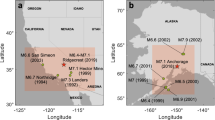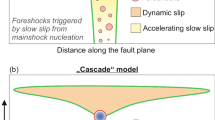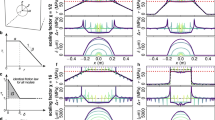Abstract
IN a paper presented at a meeting of the Seismological Society of America on April 29, 19551, we have revised previous work2 on the relation of earthquake magnitude M to energy E (in ergs). Methods formerly used to extend the magnitude scale for local earthquakes to teleseisms lead to inconsistencies, so that in effect three different magnitude scales are in use: (1) M L, the magnitude originally defined by Richter3 for local earthquakes in California as recorded on standard torsion seismometers. (2) M S, that based on calculated ground amplitudes for surface waves of periods of about 20 sec. in shallow teleseisms. (3) M B, that based on the amplitude/period ratio in body waves for both shallow and deep earthquakes.
This is a preview of subscription content, access via your institution
Access options
Subscribe to this journal
Receive 51 print issues and online access
$199.00 per year
only $3.90 per issue
Buy this article
- Purchase on SpringerLink
- Instant access to full article PDF
Prices may be subject to local taxes which are calculated during checkout
Similar content being viewed by others
References
Gutenberg, B., and Richter, C. F., submitted to Bull. Seismol. Soc. Amer.
Gutenberg, B., and Richter, C. F., Bull. Seismol. Soc. Amer., 32, 163 (1942).
Richter, C. F., Bull. Seismol. Soc. Amer., 25, 1 (1935).
Author information
Authors and Affiliations
Rights and permissions
About this article
Cite this article
GUTENBERG, B., RICHTER, C. Magnitude and Energy of Earthquakes. Nature 176, 795 (1955). https://doi.org/10.1038/176795a0
Issue date:
DOI: https://doi.org/10.1038/176795a0
This article is cited by
-
Experimental investigation on mechanical behaviors and microstructure responses of the coking coal subjected to freeze-thaw cycles
Journal of Central South University (2023)
-
The 2023 Earthquake in Türkiye and Implications for China’s Response to Catastrophe
International Journal of Disaster Risk Science (2023)
-
Debris flows in Lebai gully along the Yarlung Tsangpo River in Tibet: characterization, causes, and dynamic prediction of potential debris flows
Environmental Earth Sciences (2023)
-
Effects of Water Saturation Pressure on Crack Propagation in Coal under Uniaxial Compression
Natural Resources Research (2023)
-
Energy Evolution and Fracture Behavior of Sandstone Under the Coupling Action of Freeze–Thaw Cycles and Fatigue Load
Rock Mechanics and Rock Engineering (2023)



